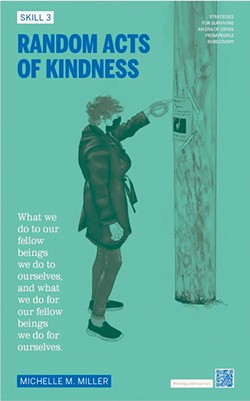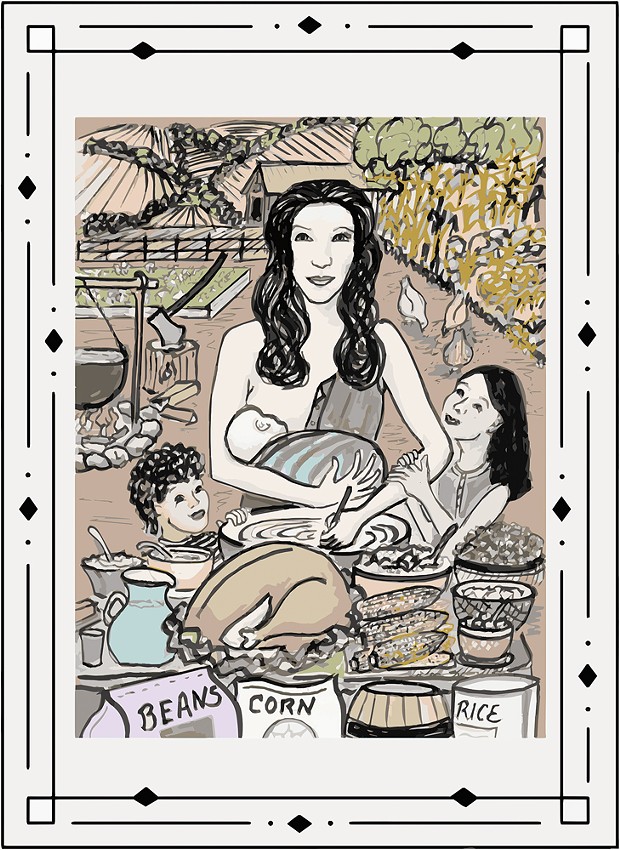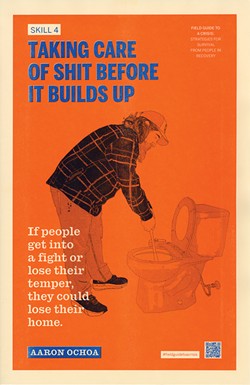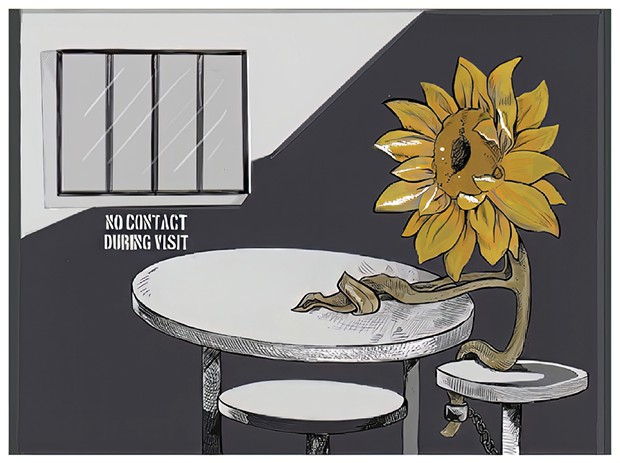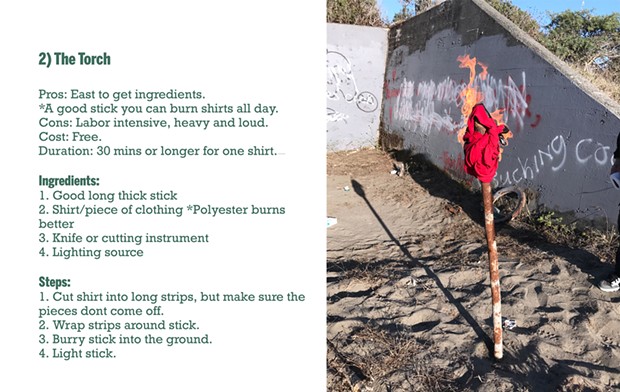Wounded Healers for Post-Pandemic Times
Field Guide to a Crisis at Morris Graves and Old Town Ink Lab
By L.L. Kessner[
{
"name": "Top Stories Video Pair",
"insertPoint": "7",
"component": "17087298",
"parentWrapperClass": "fdn-ads-inline-content-block",
"requiredCountToDisplay": "1"
}
]
Michelle M. Miller did her first acrylic paint pour in the fall of 2019. A self-described agoraphobic at the time, Miller says she almost never left her home as a result of fear. When a friend invited her to see and make some art however, she decided to try. Doing so, she met Eureka-based socially engaged artist Justin M. Maxon and started a transformative artistic journey through recovery, some of the fruit of which is on view at the Field Guide to a Crisis exhibit at the Morris Graves Museum of Art.
Maxon, a lecturer in Art and Film at Cal Poly Humboldt, is co-creator of Field Guide to a Crisis, an ongoing, multi-aspect project that challenges conventional notions of authority by providing structure and resources for members of the addiction recovery community to become "educators in resiliency." Maxon himself is 20 years clean and wanted to make art that could flip common negative perceptions about individuals suffering from substance-use disorder. He developed a project that upends the relationship between student and teacher, calls into question ingrained ideas about who is an expert and disrupts some of the stigma around addiction.
A native of Eureka and Hoopa, Maxon was living in Eureka when the pandemic hit. He observed that the isolation and the interruptions of community and support systems the general public was experiencing were all-too-familiar conditions for members of the recovery community, who are often cut off from their families and cast out from mainstream society. To Maxon, these individuals were experts in navigating the negative conditions that were a new reality for much of the public. Who better to educate people on how to get through? Maxon, along with project co-conceptualizer Marina Lopez, imagined that, with the right support, members of the recovery community could teach their survival skills to the public. In so doing, they would position themselves in roles of authority, as citizens of value, and perhaps shift some common opinions about those with histories of addiction.
Maxon began a journalism career on the East Coast after college. He focused on long-format documentary work that investigated the white gaze, environmental racism and unsolved murder. Maxon was interested in organizing community but realized that he didn't have the resources or vocabulary to do, so he went back to school for a master's of fine arts degree in art and social practice at Portland State University. He decided to concentrate on community building and social justice efforts in the realm of art because, he says, more than other disciplines, art allows for "multiple entry points" and the possibility of disrupting power systems. "Any structure," Maxon sates, "is possible within an art context."
In Maxon's own recovery from addiction, the support and guidance of a mentor were integral. Rosendo Medina, an Apache elder and then caseworker for the now defunct Arcata Endeavor social services program, saw and encouraged strengths in Maxon, who ultimately became a chosen son. Maxon articulates his efforts to support the recovery community as a way to carry on Medina's legacy. Through Field Guide, he aims to help participants identify hidden skills they can then pass on to others, continuing a chain of mutually beneficial mentorship.
Even before the pandemic, Maxon was aware there were gaps in resources for people working to overcome addiction, who often move from treatment centers to sober living houses and can feel somewhat rudderless transitioning out of intuitional living afterward. Community-based recovery fellowships like Alcoholics Anonymous and Narcotics Anonymous can bridge this gap. At the very beginning of the pandemic, AA and NA meetings were immediately available on Zoom, but not all who had previously availed themselves of these recourses made the adjustment to online meetings. Maxon saw how the disruption of the day-to-day structures of recovery lifestyles were having a detrimental effect on recovering addicts. He thought group artwork could be a way to build community within recovery houses during the reconfiguration of their support systems. Through National Geographic and Humboldt Area Foundation grants, Maxon was able to pay voluntary participants as contributing artists and help them continue to be (or become) self-supporting, and to foster self-confidence and a sense of personal accomplishment.
Field Guide to a Crisis, which was sponsored by Cooperation Humboldt and is now a Dreammaker project of the Ink People, evolved through many revisions with the financial support of the California Arts Council and the Center for Photographic Art, in addition to The National Geographic Society and the Humboldt Area Foundation. While it began with the offering of creative prompts to residents of sober living houses in the area to encourage community during the pandemic, it developed into a process that fosters the abilities of residents to figure who they are and who they want to be, utilizing storytelling as a way to generate a vividness in being present. In the current formulation of Field Guide, participants identify skills they have learned in their recovery that can be beneficial to larger communities. Working collaboratively and with Maxon's facilitation, they draft lesson plans to transfer their beneficial knowledge to others, to become educators in resiliency. Maxon envisions the whole program as a kind of "alternative school" that allows people to participate for the duration, first as students, then as instructors. He hopes the next steps will include employment support for those in recovery.
At the Morris Graves Museum of Art on Saturday, May 6, Maxon and a few Field Guide educators in resiliency, including Michelle M. Miller, presented their lessons to a public audience. Each of the participants introduced themselves and stated a demarcation of sober time. One at a time, they told refined stories of their experiences through addiction and recovery. Several noted transformative and healing effects of the examination of their histories through the process of telling their stories. Then, with the use of projected PowerPoint slide images and text, they introduced and explained their survival skills.
Upstairs in the Knight Gallery, a selection of Field Guide artworks were on view. The work included drawings, photographs and collages by participants, most of which examined their past traumas and explored subjective experiences of addiction. There were also several stylized color posters showcasing line illustrations of specific survival skills by Maxon and Matthew Contros, and paperback books available with illustrations, project descriptions, skills and exercises printed by Brown Printing in Oregon.
Produced with the help of Tibora Bea, the May 6 event covered: Tackling Resentments, Responding on the Fly and Synchronicity. Miller, who now describes herself as living "one day at a time" in recovery, lectured on the healing effects of random acts of kindness.
Miller says she had "tried every anti-depressant on the market" and nothing worked. What she discovered did work was "getting outside of self." Miller notes she no longer needs anti-depressants. She believes non-addicts can benefit similarly from acting selflessly. "Any crisis requires skills to cope," she explains. "People might not learn [these skills] at home or in school or have a habit [like addiction] that requires them to change their behavior" to help others. But they can learn from the experiences and efforts of people in recovery.
Miller operates a hub within the alternative economy that exists among homeless folks in Eureka. She provides a kind of storehouse of useful objects for this often ignored and/or maligned segment of Humboldt society. Hanging on to things people need, she gives items away to people who come looking for them. The informal operation benefits the community outside Miller's door and, likewise, benefits Miller in her own recovery and well-being.
Confidence is one of the key benefits Miller says she has gained through her participation in Field Guide for a Crisis, describing her work with the program as something she "can be proud of." She expresses her gratitude for the opportunity to invite family to the public events and show them she's "past the stumbling block."
While Maxon is quick to note sobriety is not a requirement for participation in Field Guide, Miller and other speakers at the MGMA event discussed the art-making and mentorship project as an alternative to other substance-use recovery methods.
"There are alternatives to the standard approaches to recovery," Miller says. "This one is more adventurous."
However, the skills taught by the participant-educators at the MGMA event are largely drawn from the AA program. Getting out of self-centered obsession through acts of service, taking personal inventory of resentments and looking for meaning in everyday coincidences are all articulated in the book Alcoholics Anonymous as effective components in a structured program of personality transformation to bring about freedom from addiction. These strategies are core aspects of contemporary AA and its derivative, Narcotics Anonymous. AA notes explicitly in its literature, though, that it does not have a monopoly on recovery from addiction and the program of AA definitely did not originate in a vacuum.
Glimmers of sobriety occurred in the 1920s for members of the Oxford Group, a then-popular Christian organization that believed fear and selfishness were the root of human troubles. The sobriety of one member named Ebby led to the adaptation of some of the Oxford Group's tenets for the specific purpose of achieving freedom from addiction and to the formation of AA by two other alcoholics, Bill W. and Dr. Bob. The philosophies and practices of AA, which is not affiliated with any organized religion or outside entity, are also heavily influenced by the work of psychologist Carl Jung, who, among other contributions, developed the term synchronicity.
The idea that humans can be healed by healing others is not a new one. The notion that one's injuries can imbue an ability to heal has a similarly deep history. Jung created the term "wounded healer" to name a variety of conditions that can develop out of the relationships between the psychological wounds of psychoanalysts and their patients. In this view, it is the wound of the analyzer — the wound of the healer — that, when properly managed, can enable them to heal others. While Jung was working specifically within psychology, the basic notion goes back further and has a broader span. In ancient Greek mythology, which Jung studied and referenced, a character named Chiron was struck by a poisoned arrow and possessed the power to heal others. Like Jung's psychology and Chiron's medicine, storytelling and art can be healing disciplines through which a wounded healer may be able to heal others.
Field Guide has roots in an artistic traditions, too. Socially engaged art practice — a collaborative process where people can be the medium, rather than just its creators and viewers — has a long lineage and, like activist art, frequently addresses social and political issues. It's related also to new genre public art, which entails direct engagement with a public audience, in this case an art talk and the show's upcoming workshops, with roots in the much older tradition of community art, which involves dialogue, usually occurs in a community setting with individuals who may not otherwise make art, typically guided by a professional artist.
Field Guide to a Crisis educators in resiliency will conduct four additional free, hands-on workshops at Old Town Ink Lab, in Eureka. (See details below.) By attending one or more of these workshops, Humboldt County residents and visitors can learn how some members of the recovery community apply practical and spiritual skills, and discover how to cultivate greater resiliency in their own lives.
Miller will lead the first workshop July 8 and address random acts of kindness in-depth. She will articulate through her experience about how small acts of selfless generosity benefit the giver and lead participants to develop a practical plan for the application of this skill. Working collaboratively, the group will brainstorm specific acts of kindness that could aid the community immediately outside the Ink Lab, work together to create a map of kindness, and finally to execute some random acts of kindness.
"Helping others helps me in recovery," Miller says.
For Maxon, supporting recovery communities allows him to pass on what he received from his mentor. For viewers and audience participants, Field Guide to a Crisis may offer a reflexive and personally enriching experience. According to Maxon, Field Guide to a Crisis and socially engaged art in general, constitute art that lives in "the realm of the real, not just the symbolic."
Field Guide to a Crisis survival skill workshops will be held from 1 to 3 p.m. July 8, 15 and 22 at Old Town Ink Lab 212 G St,. No. 103, in Eureka, with the fourth session to be determined. The events are free and open to the public. Registration is available at eventbrite.com.
The Field Guide for a Crisis art exhibition is on view in MGMA's Knight Gallery (636 F. St. in Eureka) through June 4, from noon to 5 p.m. Wednesdays through Sundays. Admission is $5 for adults and $2 for seniors and students with ID. Museum members and children under 17 are free. The guide can also be explored online at fieldguidetoacrisis.com.
L.L. Kessner is an Arcata-based artist and writer.
more from the author
-
New Art Sellers Around Old Town:
Stock Schlueter Fine Art and 4th Street Mercantile
- Jan 25, 2024
-
Full Circle Journey
Robert Benson's Tintah: Amongst the Trails at the Goudi'ni Native American Arts Gallery
- Oct 26, 2023
-
Sea of Possibilities
Emily Jung Miller's Ghost Net Landscape at the Reese Bullen Gallery
- Sep 28, 2023
- More »
Latest in News
Readers also liked…
-
Through Mark Larson's Lens
A local photographer's favorite images of 2022 in Humboldt
- Jan 5, 2023
-
'To Celebrate Our Sovereignty'
Yurok Tribe to host gathering honoring 'ultimate river warrior' on the anniversary of the U.S. Supreme Court ruling that changed everything
- Jun 8, 2023
